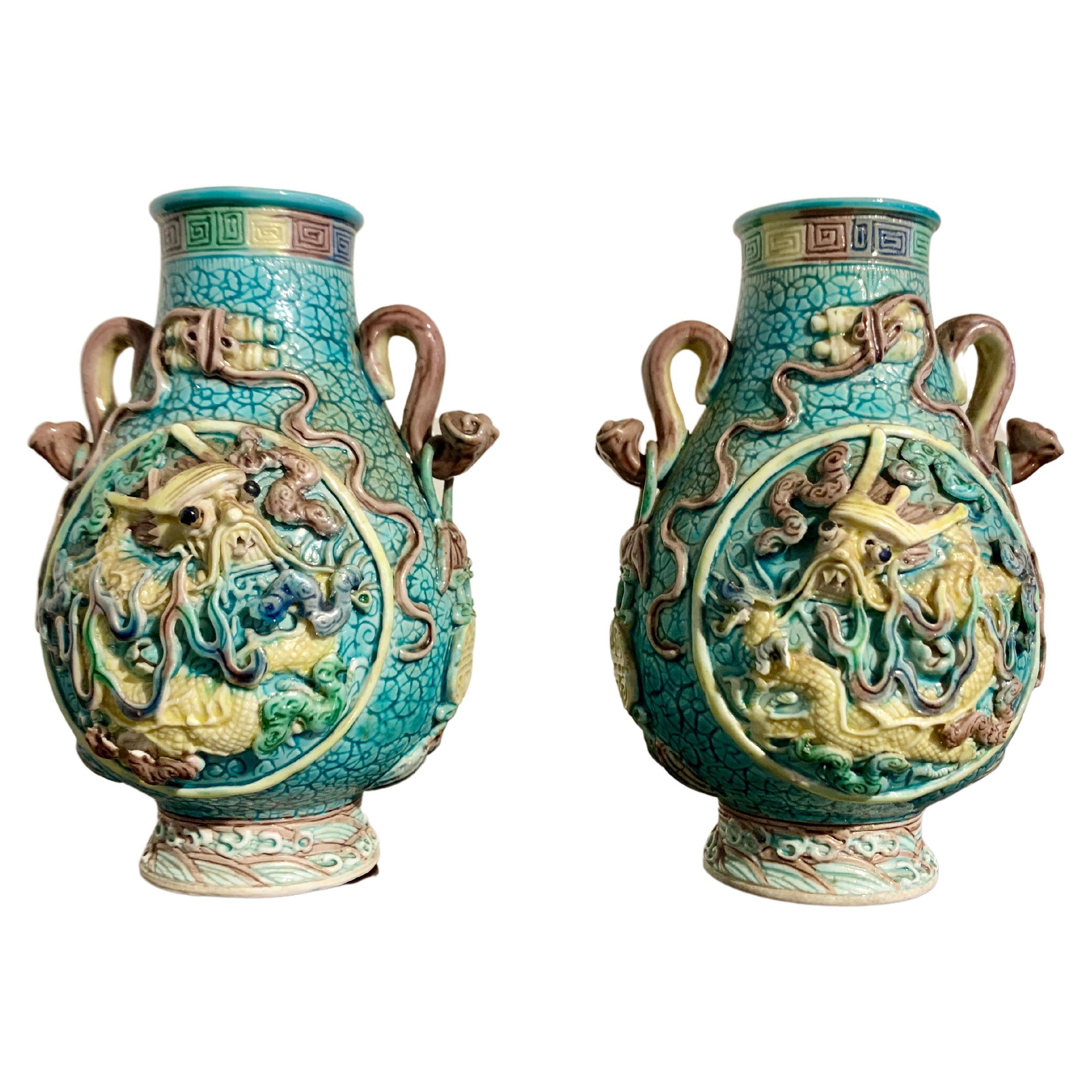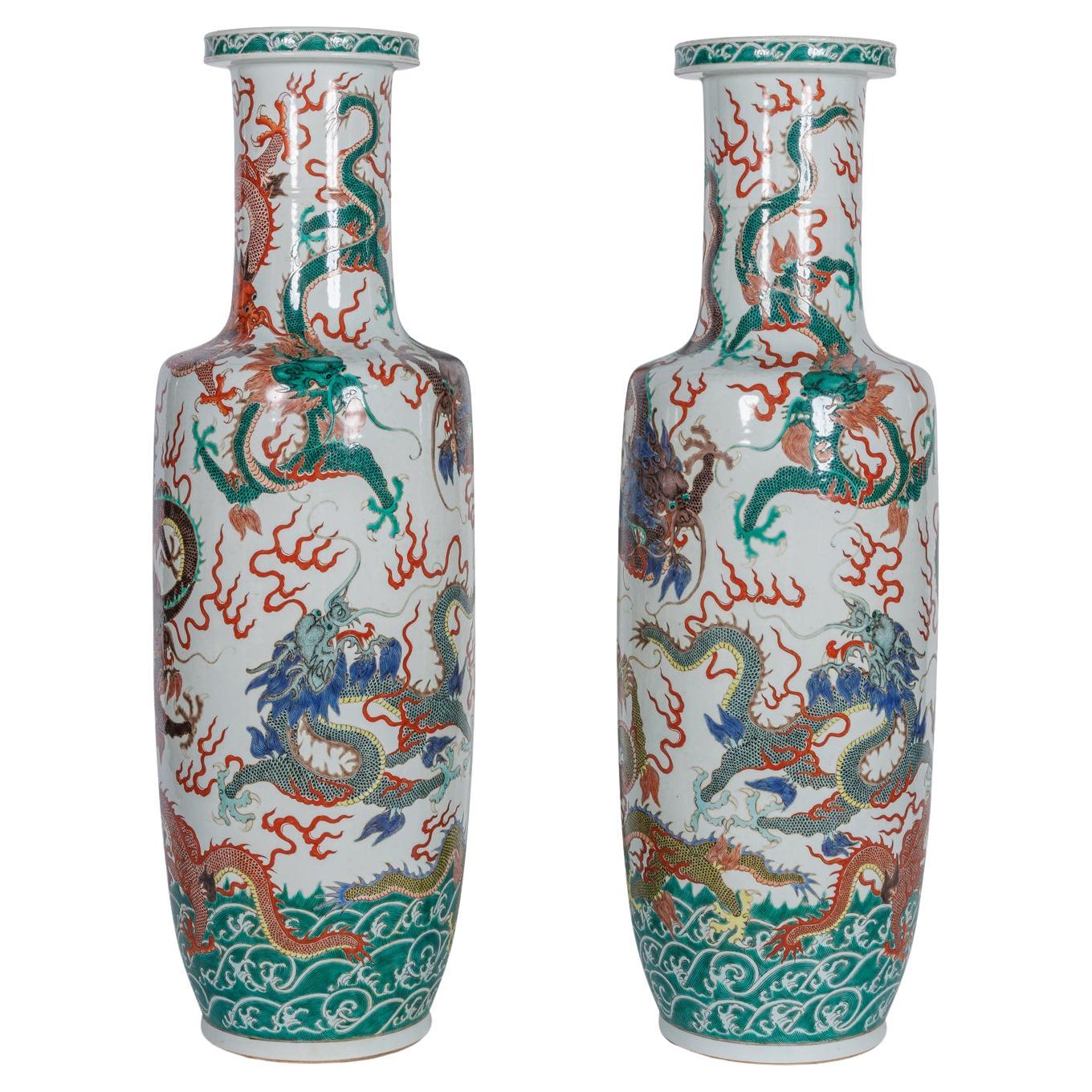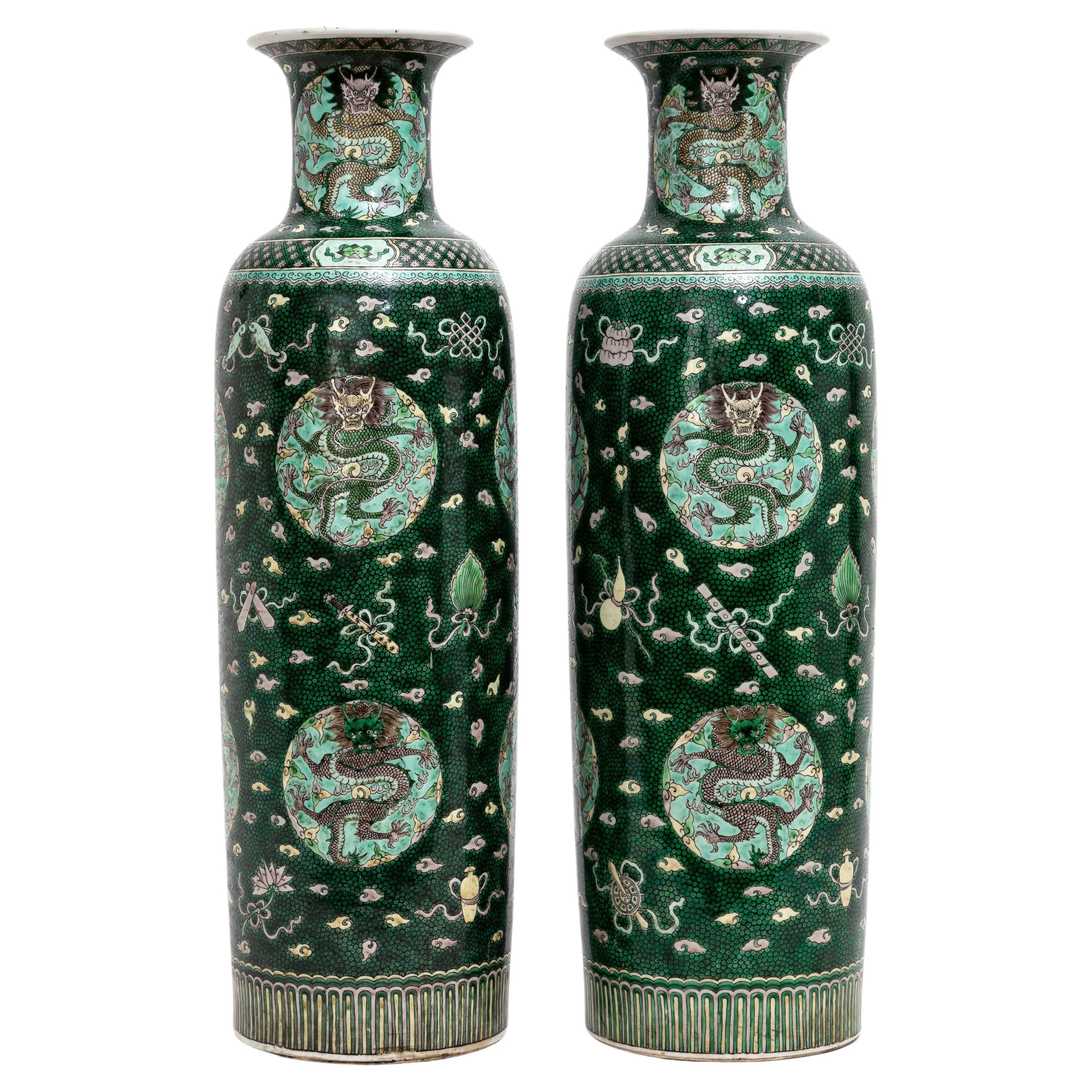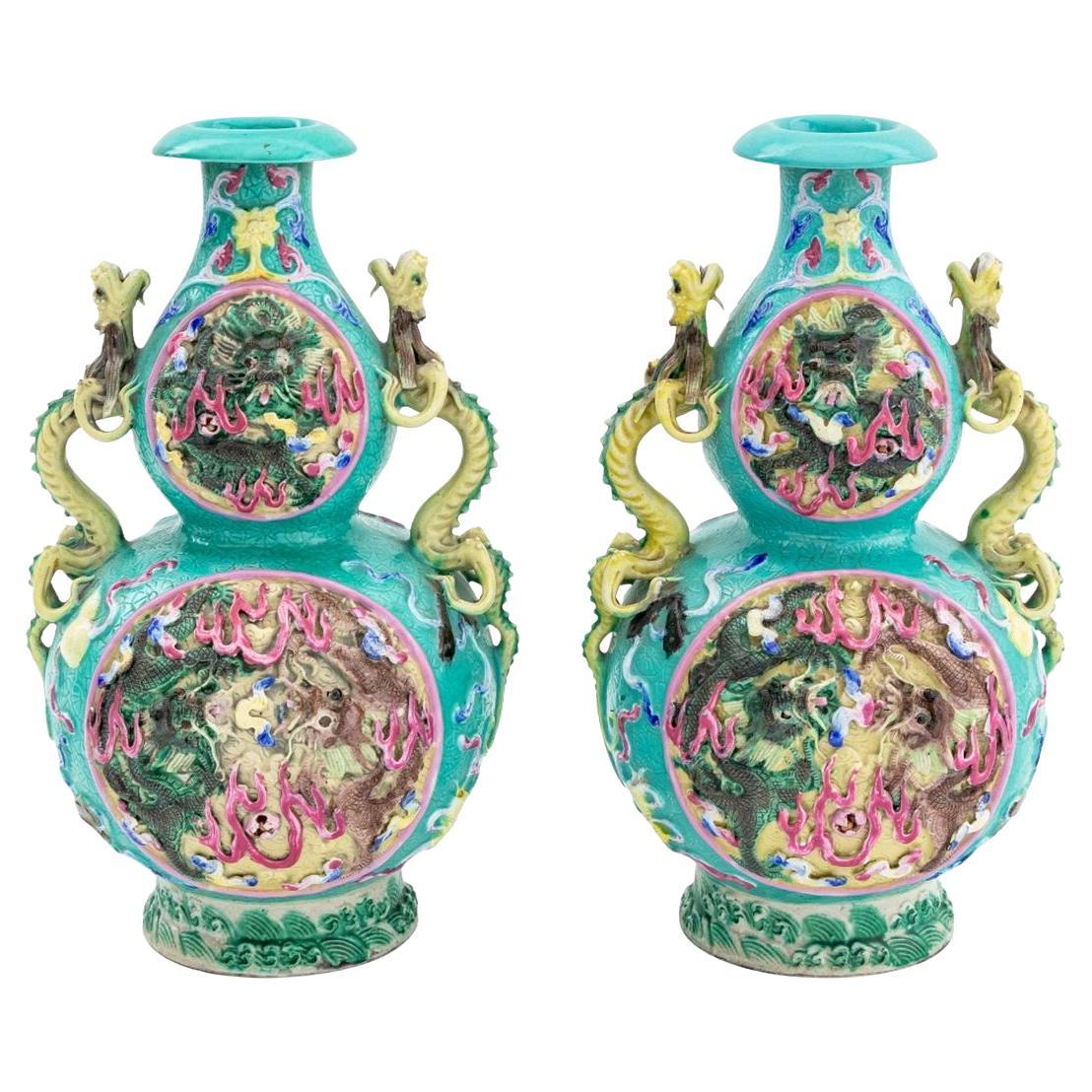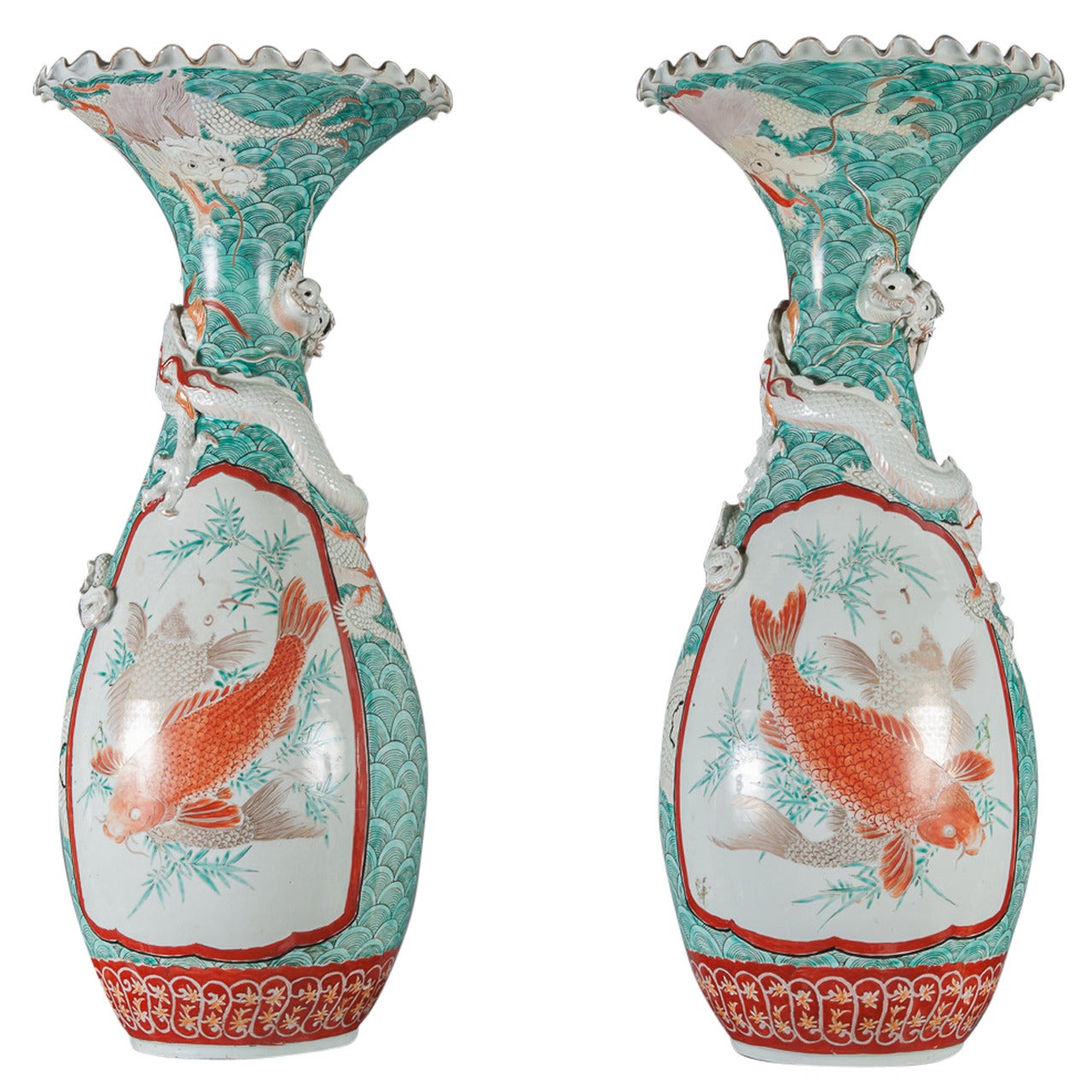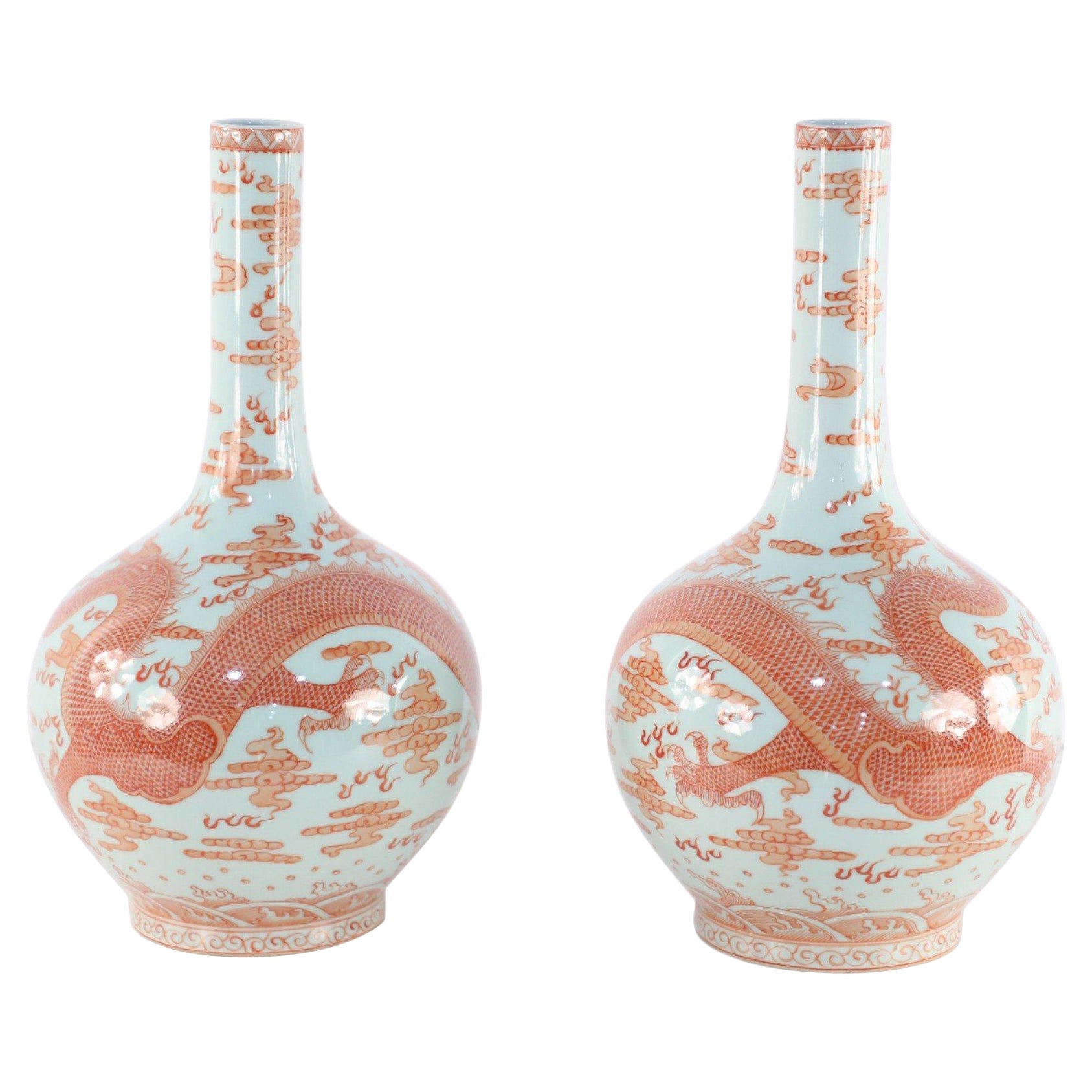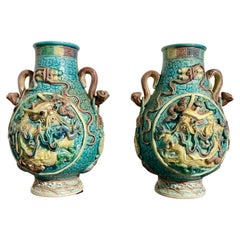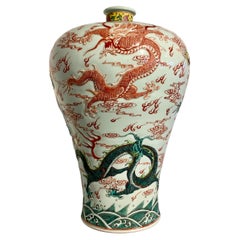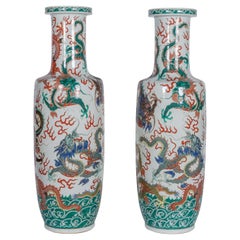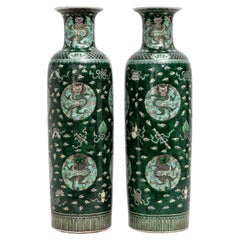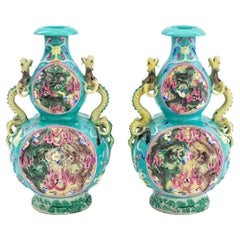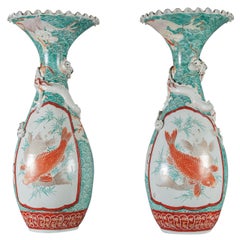Items Similar to Pair Chinese Dragon Fish Glazed Porcelain Vase, Qing Dynasty, 19th-20th Century
Want more images or videos?
Request additional images or videos from the seller
1 of 18
Pair Chinese Dragon Fish Glazed Porcelain Vase, Qing Dynasty, 19th-20th Century
$4,500per set
£3,440.49per set
€3,962.75per set
CA$6,305.88per set
A$7,039.92per set
CHF 3,688.81per set
MX$86,175.55per set
NOK 46,847.96per set
SEK 44,171.68per set
DKK 29,574.40per set
About the Item
A fantastic pair of Chinese molded and glazed biscuit porcelain vases with leaping dragon fish or makara, late Qing dynasty, circa 1900.
The vases of baluster form, each molded in high relief with a pair of dragon fish, also known as makara, leaping up the sides, a stream of water spewing from their mouths. The foot of the vase decorated with crashing waves, the neck with a cloud design.
An apocryphal Da Qing Qianlong Nian Zhi impressed mark to the underside.
The vases crafted from a fine biscuit porcelain and glazed in muted tones of yellow, turquoise green, and aubergine.
Ex. Christie's, NY.
- Dimensions:Height: 6.5 in (16.51 cm)Width: 4 in (10.16 cm)Depth: 2.5 in (6.35 cm)
- Sold As:Set of 2
- Style:Qing (Of the Period)
- Materials and Techniques:
- Place of Origin:
- Period:1900-1909
- Date of Manufacture:circa 1900
- Condition:Wear consistent with age and use. With one firing crack to the foot of one vase and some minor kiln adhesion to the body, as seen in photos. No chips, cracks or repairs noted.
- Seller Location:Austin, TX
- Reference Number:1stDibs: LU894713704461
About the Seller
5.0
Platinum Seller
Premium sellers with a 4.7+ rating and 24-hour response times
Established in 2001
1stDibs seller since 2010
345 sales on 1stDibs
Typical response time: <1 hour
- ShippingRetrieving quote...Shipping from: Austin, TX
- Return Policy
Authenticity Guarantee
In the unlikely event there’s an issue with an item’s authenticity, contact us within 1 year for a full refund. DetailsMoney-Back Guarantee
If your item is not as described, is damaged in transit, or does not arrive, contact us within 7 days for a full refund. Details24-Hour Cancellation
You have a 24-hour grace period in which to reconsider your purchase, with no questions asked.Vetted Professional Sellers
Our world-class sellers must adhere to strict standards for service and quality, maintaining the integrity of our listings.Price-Match Guarantee
If you find that a seller listed the same item for a lower price elsewhere, we’ll match it.Trusted Global Delivery
Our best-in-class carrier network provides specialized shipping options worldwide, including custom delivery.More From This Seller
View AllPair Small Chinese Dragon Vases, Molded and Glazed Porcelain, Republic Period
Located in Austin, TX
A fabulous pair of small Chinese molded and glazed biscuit ware porcelain dragon vases with loose eyes and apocryphal Qianlong mark, Republic Period, circa 1920, China.
The small ...
Category
Vintage 1920s Chinese Qing Ceramics
Materials
Porcelain
Large Chinese Porcelain Five Dragon Meiping Vase, Modern, China
Located in Austin, TX
A large and powerful Chinese famille rose enameled porcelain "Five Dragon" meiping vase, modern, China.
The oversized vase of traditional meiping form, with a splayed foot supporting a baluster shaped body with high shoulders, short, narrow neck, and rolled mouth rim.
The large vase decorated with five dragons molded in relief. Their bodies painted in vibrant overglaze famille rose enamels of reds, greens, yellows and turquoise.
The dragons portrayed dancing in the sky among flames and clouds. Their bodies twisting and writhing, claws extended, tails coiled, some with mouths open in triumphant roars. The main dragon in red, and portrayed to more directly face the viewer.
The dragons dance against a white ground sky. The blank sky broken up by overglaze red painted stylized clouds and flames. The foot decorated with a band of crashing waves. A stylized lotus blossom surrounds the base of the neck. The neck with a band of scrolling flowers and vines against a yellow ground.
The underside of the large vase with an apocryphal "Da Qing Qianlong Nian Zhi...
Category
Early 2000s Chinese Qing Ceramics
Materials
Porcelain
Pair Japanese Cloisonne Dragon and Phoenix Jardinieres, Meiji Period
Located in Austin, TX
A lovely pair of Japanese chakinseki, tea dust, cloisonne jardinieres, Meiji Period, circa 1900, Japan.
The jardinieres each with a squat globular body, short neck, and wide, everted mouth. The bodies decorated wide lappets of mottled puce featuring alternating dragons and phoenixes...
Category
Antique Early 1900s Japanese Meiji Planters, Cachepots and Jardinières
Materials
Copper, Enamel
Two Small Japanese Cloisonne Dragon Vases, Early 20th Century, Japan
Located in Austin, TX
Two charming, small Japanese cloisonné dragon vases, Meiji to Taisho period, early 20th century, Japan.
The miniature vases of baluster f...
Category
Early 20th Century Japanese Taisho Metalwork
Materials
Copper, Enamel, Foil
Japanese Satsuma Dragon Vase, Meiji Period, c 1900, Japan
By Satsuma
Located in Austin, TX
A fantastic small Japanese Satsuma vase with image of writhing dragons, Meiji Period, circa 1900, Japan.
The vase of elegant baluster form, with a slightly flared foot, slender body...
Category
Antique Early 1900s Japanese Meiji Ceramics
Materials
Ceramic, Porcelain, Pottery, Stoneware, Hardwood
Pair Chinese Porcelain Foo Dog Covered Jars, mid 20th Century, China
Located in Austin, TX
A delightful pair of Chinese famille verte enameled porcelain covered jars with foo lions, circa 1960's, China.
The jars of baluster form and painted in bold and bright famille vert...
Category
Vintage 1960s Chinese Qing Jars
Materials
Porcelain
You May Also Like
A Highly Rare Pair of Monumental Qing Dynasty Rouleau Porcelain "Dragon" Vases
Located in Queens, NY
A Highly Rare Pair of Monumental Qing Dynasty Rouleau Porcelain "Dragon" Vases
A Masterful Display of 19th Century Chinese Artistry:
The mid-19th century Qing Dynasty marked a period of artistic innovation and imperial grandeur, as exemplified by this rare and monumental pair of Rouleau vases. These exceptional porcelain works, notable for their commanding size and vibrant palette, are a testament to the unparalleled craftsmanship that flourished during this era. Embellished with a dynamic tableau of dragons rendered in bold hues of red, green, blue, brown, and yellow, these vases embody both artistic brilliance and the deep cultural symbolism woven into Chinese decorative arts.
Artistic Excellence and Symbolism:
At the heart of these magnificent vases lies a visual narrative that channels the power and mystique of the dragon, a central motif in Chinese culture symbolizing imperial authority, strength, and cosmic energy. The intricate depiction of dragons in motion, intertwined amidst stylized ocean waves, conveys a sense of fluidity and dynamic movement. Each color used—the crimson reds, verdant greens, striking blues, earthy browns, and golden yellows—has been meticulously applied, reflecting a mastery of the high-fired, polychrome enameling techniques perfected during the Qing Dynasty.
The Rouleau form, with its cylindrical body, short neck, and slightly flared mouth, was a favored shape for large-scale vases in the 18th and 19th centuries. The form’s structured elegance allowed for expansive decorative panels, serving as an ideal canvas for intricate, multi-layered designs. This pair demonstrates how artisans skillfully balanced the flowing movement of the dragons with the rhythmic motifs of waves, resulting in a harmonious composition that engages the viewer from every angle.
Craftsmanship and Technique:
These vases represent the pinnacle of porcelain artistry achieved under the Qing Dynasty, showcasing techniques that reflect centuries of refined craftsmanship. The precision in the application of overglaze enamels and the expert manipulation of kiln temperatures to achieve vibrant and consistent coloration are indicative of the expertise within the imperial kilns. The dragons' scales, rendered with remarkable detail, create a textured effect that contrasts beautifully with the smooth, undulating waves, enhancing the three-dimensional quality of the design.
The depth of color and the crisp delineation of each element point to a rigorous and time-intensive process. These qualities signify the involvement of highly skilled artisans who adhered to the imperial standards set by the royal court, ensuring that each piece was a fitting representation of the empire’s wealth and cultural prowess.
Historical and Cultural Significance:
Vases of this caliber were not merely decorative; they were imbued with profound symbolic meaning and often commissioned for imperial use or gifted as prestigious diplomatic offerings. The dragon motif, deeply embedded in Chinese folklore and philosophy, was associated with the emperor himself—known as the "Son of Heaven"—and symbolized his divine right to rule. These vases also reflect the Qing Dynasty's flourishing export trade and the global fascination with Chinese porcelain during the 19th century. European collectors and royal patrons prized such pieces for their artistry and the exoticism they represented, contributing to a legacy that elevated Chinese porcelain to a revered status in the annals of decorative art history.
Provenance and Collectability:
The extraordinary scale, exceptional craftsmanship, and rarity of this pair establish them as museum-quality works. Such vases would have held a place of honor in a palace or wealthy estate, reflecting not only the owner’s status but also an appreciation for the profound cultural and artistic traditions of China. Their provenance—potentially tied to an imperial commission or significant historical collection—underscores their importance as objects of study and admiration.
Provenance:
Private American Collection, acquired in London, circa 1905.
Thence by descent to the current owners
Solomon Treasure...
Category
Antique Mid-19th Century Chinese Qing Ceramics
Materials
Porcelain
A Pair 18 C. Chinese Kangxi Porcelain Famille Verte Fish-Roe Ground Dragon Vases
Located in New York, NY
A Large and Highly Rare Pair of 18th Century Chinese Kangxi Porcelain Sleeve Form Famille Verte and Fish-Roe Ground Five-Claw Imperial Motif Dragon Vases. Of slender Sleeve form wit...
Category
Antique 18th Century Chinese Other Ceramics
Materials
Porcelain
Chinese Porcelain Double Gourd Vases, Pair
Located in Astoria, NY
Pair of Chinese Porcelain Double Gourd Vases, 20th century, each with relief dragons with articulated eyes on blue ground and two green dragon form handles, stamped with Qianlong six...
Category
20th Century Chinese Qing Ceramics
Materials
Porcelain
$1,450 / set
A Pair of Antique Japanese Porcelain Vases with Dragon Motif
Located in Los Angeles, CA
A Pair of 19th century Japanese Kutani Porcelain baluster Vases with Nishikigoi (koi) Motif. Each of baluster form with a flared ruffled mouth, beautifully decorated with red coy fis...
Category
Antique Late 19th Century Japanese Porcelain
Materials
Porcelain
Pair of Chinese Qing Dynasty Style Gray & Alum Red Dragon Motif Porcelain Vases
Located in Queens, NY
PAIR of Chinese Qing Dynasty Yongzheng Period-style (Mid-20th Century) light gray porcelain vases with globular forms wrapped in alum red glaze dragon motifs (mark on bottoms) (PRICE...
Category
Mid-20th Century Chinese Qing Vases
Materials
Porcelain
Pair of Chinese Qing Dynasty Style Red Dragon Motif Meiping Porcelain Vases
Located in Queens, NY
PAIR of Chinese Qing Dynasty Yongzheng Period-style (Mid-20th Century) light gray porcelain vases with Meiping forms wrapped in orange red alum glaze dragon motifs (mark on bottoms, ...
Category
Mid-20th Century Chinese Qing Vases
Materials
Porcelain
More Ways To Browse
Chinese Dragon
Antique Chinese Dragons
Dynasty Fine China
Biscuit Porcelain
Qing Dynasty Vase
Chinese Porcelain Dragon
Qing Qianlong
Qing 20th Century Porcelain
Chinese Antique Green Glaze Ceramics
Green Dragon China
Chinese Yellow Glaze
Qing Dynasty Green
Yellow And Green Chinese Ceramics
Fish Mold
Vase Qing Dynasty 19th Century
Chinese Turquoise Glaze
Chinese Turquoise Glazed
Chinese Turquoise Porcelain
